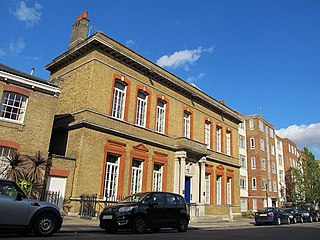
Linford Manor, also known as Great Linford Manor, is a seventeenth-century mansion or manor house converted into a recording studio complex in Great Linford, a district in Milton Keynes, England. It is now owned by Pete Winkelman who is chairman of Milton Keynes Dons football club.

BBC Radio Northampton is the BBC Local Radio service for the English county of Northamptonshire. It broadcasts from its studios in Broadcasting House, Abington Street, Northampton on 104.2FM (Northampton) and 103.6FM, and also on DAB.

The Northampton & Lamport Railway is a standard gauge heritage railway in Northamptonshire, England. It is based at Pitsford and Brampton station, near the villages of Pitsford and Chapel Brampton, roughly 5 miles (8.0 km) north of Northampton.
The IBC Recording Studios were recording studios located at 35 Portland Place, London, England. In the 1960s and 1970s the studios become internationally famous after being used by some of the biggest recording artists in the world.

Rockfield Studios is a recording studio just outside the village of Rockfield, Monmouthshire, Wales.
Northampton College is a further education college in Northampton, England, which opened in 1973, following building work which started in 1970.

Collingtree Park is a district in the Borough of Northampton in the East Midlands of England.
Nemo Studios was a recording studio in London, planned, built and used by Greek composer Vangelis between 1975 and 1987. Numerous highlights of Vangelis' career were composed in Nemo, including soundtracks for Ridley Scott's Blade Runner, and Hugh Hudson's Chariots of Fire.

Westlake Recording Studios is a music recording studio in West Hollywood, California.

Maida Vale Studios is a complex of seven BBC sound studios, of which five are in regular use, in Delaware Road, Maida Vale, London.

RAK Studios is a recording studio complex with residential facilities located near Regent's Park in central London, United Kingdom. It was founded in 1976 by English record producer Mickie Most. RAK has four recording rooms. Studios 1 and 2 house API desks; Studio 3 has a vintage Neve VRP Legend console ; and Studio 4 contains an SSL 4056 desk.
Yamaha Pro Audio, Inc. is division of the Yamaha Corporation. It offers a complete line of beginner professional audio products for the live sound and sound reinforcement markets. It has a long history of introducing significant products for the professional audio market such as the PM-1000 modular mixing console, the REV1 and SPX90 digital signal processors, and the 01, 02R, PM1D, PM5D, QL5, M7CL, CL5, and PM10/7 Rivage digital mixing consoles.

Blackwing Studios was an English recording studio, most notable for early Depeche Mode and Yazoo recordings in the early 1980s.
Dark Horse Recording Studios is located in Franklin, Tennessee, originally opened in 1993 and expanded in 2009. Its early client base consisted of Neil Diamond, Faith Hill, and Martina McBride; it was designed and built by author, speaker, and recording artist Robin Crow.

Northampton Bridge Street is a former railway station in Northampton, the main town of Northamptonshire, on the Northampton and Peterborough Railway which connected Peterborough and Northampton.
Northampton St. John's Street was a railway station and the northern terminus of the Midland Railway's former Bedford to Northampton Line which served the English county town of Northampton from 1872 to 1939. Its closure came about as a cost-cutting measure implemented by the London, Midland and Scottish Railway which diverted services to the nearby Northampton Castle station. After closure the elegant station building was used as offices and the line for the storage of rolling stock; the site was cleared in 1960 to make way for a car park. The car park has now been built on and is the location of St Johns Halls of Residence for The University of Northampton.
Hunsbury Hill is an Iron Age hill fort two miles (3 km) south-west of the centre of the town of Northampton in the county of Northamptonshire.

Odyssey Studios was a recording studio based near Marble Arch in London and opened in 1979. It was set up by Wayne Bickerton as an extension of State Records, the label he had set up with Tony Waddington and John Fruin in 1975. The studio closed in 1989 and the building was subsequently sold to Jazz FM.

The Yamaha NS-10 is a loudspeaker that became a standard nearfield studio monitor in the music industry among rock and pop recording engineers. Launched in 1978, the NS-10 started life as a bookshelf speaker destined for the domestic environment. It was poorly received but eventually became a valuable tool with which to mix rock recordings. The speaker has a characteristic white-coloured mid–bass drive unit.

Finedon Top Lodge Quarry, also known as Finedon Gullet is a 0.9 hectare geological Site of Special Scientific Interest east of Wellingborough in Northamptonshire. It is a Geological Conservation Review site revealing a sequence of middle Jurassic limestones, sandstones and ironstones, and is the type section for a sequence of sedimentary rocks known as the 'Wellingborough Member'. It was created by quarrying for the underlying ironstone for use at Wellingborough and Corby Steelworks; the ore was transported by the 1,000 mm gauge Wellingborough Tramway.












